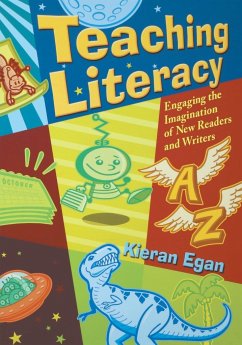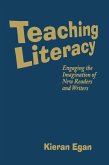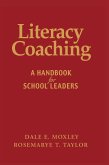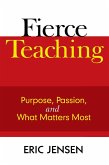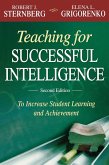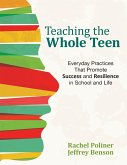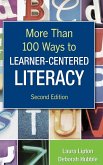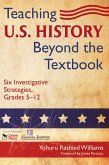- Broschiertes Buch
- Merkliste
- Auf die Merkliste
- Bewerten Bewerten
- Teilen
- Produkt teilen
- Produkterinnerung
- Produkterinnerung
This unique approach to teaching core literacy skills offers step-by-step planning frameworks and an appendix of activity ideas to show teachers how to engage students in the process.
Andere Kunden interessierten sich auch für
![Teaching Literacy Teaching Literacy]() Kieran EganTeaching Literacy73,99 €
Kieran EganTeaching Literacy73,99 €![Literacy Coaching Literacy Coaching]() Dale E. MoxleyLiteracy Coaching63,99 €
Dale E. MoxleyLiteracy Coaching63,99 €![Fierce Teaching Fierce Teaching]() Eric JensenFierce Teaching64,99 €
Eric JensenFierce Teaching64,99 €![Teaching for Successful Intelligence Teaching for Successful Intelligence]() Robert J. SternbergTeaching for Successful Intelligence82,99 €
Robert J. SternbergTeaching for Successful Intelligence82,99 €![Teaching the Whole Teen Teaching the Whole Teen]() Rachel PolinerTeaching the Whole Teen37,99 €
Rachel PolinerTeaching the Whole Teen37,99 €![More Than 100 Ways to Learner-Centered Literacy More Than 100 Ways to Learner-Centered Literacy]() Laura LiptonMore Than 100 Ways to Learner-Centered Literacy73,99 €
Laura LiptonMore Than 100 Ways to Learner-Centered Literacy73,99 €![Teaching U.S. History Beyond the Textbook Teaching U.S. History Beyond the Textbook]() Yohuru Rashied WilliamsTeaching U.S. History Beyond the Textbook73,99 €
Yohuru Rashied WilliamsTeaching U.S. History Beyond the Textbook73,99 €-
-
-
This unique approach to teaching core literacy skills offers step-by-step planning frameworks and an appendix of activity ideas to show teachers how to engage students in the process.
Hinweis: Dieser Artikel kann nur an eine deutsche Lieferadresse ausgeliefert werden.
Hinweis: Dieser Artikel kann nur an eine deutsche Lieferadresse ausgeliefert werden.
Produktdetails
- Produktdetails
- Verlag: Corwin
- Seitenzahl: 178
- Erscheinungstermin: 5. April 2006
- Englisch
- Abmessung: 254mm x 178mm x 10mm
- Gewicht: 347g
- ISBN-13: 9781412927888
- ISBN-10: 1412927889
- Artikelnr.: 22098559
- Herstellerkennzeichnung
- Libri GmbH
- Europaallee 1
- 36244 Bad Hersfeld
- gpsr@libri.de
- Verlag: Corwin
- Seitenzahl: 178
- Erscheinungstermin: 5. April 2006
- Englisch
- Abmessung: 254mm x 178mm x 10mm
- Gewicht: 347g
- ISBN-13: 9781412927888
- ISBN-10: 1412927889
- Artikelnr.: 22098559
- Herstellerkennzeichnung
- Libri GmbH
- Europaallee 1
- 36244 Bad Hersfeld
- gpsr@libri.de
Kieran Egan lives in Vancouver, British Columbia, Canada. His chapbook, 'Among the branches,' was published by Alfred Gustav Press, in June, 2019. He was shortlisted for the Times Literary Supplement Mick Imlah prize in 2017 and the Acumen International Poetry Competition, 2020, and his poems have appeared in many Canadian and International magazines His books have been published by a variety of presses. .
Preface
Two Sources of This Approach
Cognitive Tools in Everyday Teaching Practice
Literacy Learners, Young and Old(er)
The Cognitive Tool Kits of Language and Literacy
Planning Frameworks Using Cognitive Tools
Acknowledgements
About the Author
Part I: The Cognitive Toolkit of Oral Language
1. Using the Story Form: Meeting Objectives by Engaging Feelings
Stories and Feelings
Stories in the Classroom
Inventing Comic Characters
Personifying Elements of Language
Creating a Literacy Adventure
Teachers, Try It Out
Final Words
2. Images We Care About: Too, Two, and To
Images Aid Memory and Understanding
Tying Concepts to Images
From Images to Letter Representation
Teachers, Try It Out
Final Words
3. Binary Opposites: Goldilocks and Civil War
Using Opposites to Expand Upon Understanding
Mediating Binary Opposites
Teachers, Try It Out
Final Words
4. Literal and Metaphoric Talk: "Like a Spring-Woken Tree"
Recognizing and Reflecting on Language
Similes
Metaphors
Teachers, Try It Out
Final Words
5. Jokes: Drawing the Drapes
Joking and "Seeing" Language
Humor in Amelia Bedelia
Reading Puzzles
Teachers, Try It Out
Final Words
6. Rhyme and Rhythm: Mickey Mouse's Underwear
Echo Rhymes
Rhyme and Rhythm: Ring, Rang, Rung
Nursery Rhymes
Teachers, Try It Out
Final Words
7. Living Knowledge: Barbie and The Matrix
Embedding Knowledge in Students' Lifeworlds
Children¿s Lifeworlds
Conclusion to Part I
Part II: The Cognitive Tool Kit of Literacy
8. Extremes: The Queueing Subbookkeeper
The Strange, Exotic, Different, and Wonderful
Fascinating Reality
Metalinguistic Awareness
Exploring Extremes
Wonder in the Classroom
Teachers, Try It Out
Final Words
9. Everyday Heroes: Spiderman and the Comma
Heroizing Literacy Tasks
Heroes in the Classroom
Heroic Experiences
Teachers, Try It Out
Final Words
10. Human Contexts: John Montagu, The Earl of Sandwich
Knowledge in a Meaningful Context
Linking Language With Purpose
Teachers, Try It Out
Final Words
11. Collections and Hobbies: Alphabets and Beanie Babies
Collecting Letters and Words
Literacy as a Hobby
Teachers, Try It Out
Final Words
12. Graphic Organizers: Lists and Flowcharts
From the Ear to the Eye
Visual Tools
Teachers, Try It Out
Final Words
Conclusion to Part II
Part III: Planning Frameworks
13. Framework 1
Mythic Planning Framework
Example: A Lesson on Homonyms
14. Framework 2
The Romantic Planning Framework
Example: A Lesson on the Comma
The Frameworks and You
Conclusion
Appendix: Responses to the "Teachers, Try It Out" Questions by Gillian C.
Judson
References
Index
Two Sources of This Approach
Cognitive Tools in Everyday Teaching Practice
Literacy Learners, Young and Old(er)
The Cognitive Tool Kits of Language and Literacy
Planning Frameworks Using Cognitive Tools
Acknowledgements
About the Author
Part I: The Cognitive Toolkit of Oral Language
1. Using the Story Form: Meeting Objectives by Engaging Feelings
Stories and Feelings
Stories in the Classroom
Inventing Comic Characters
Personifying Elements of Language
Creating a Literacy Adventure
Teachers, Try It Out
Final Words
2. Images We Care About: Too, Two, and To
Images Aid Memory and Understanding
Tying Concepts to Images
From Images to Letter Representation
Teachers, Try It Out
Final Words
3. Binary Opposites: Goldilocks and Civil War
Using Opposites to Expand Upon Understanding
Mediating Binary Opposites
Teachers, Try It Out
Final Words
4. Literal and Metaphoric Talk: "Like a Spring-Woken Tree"
Recognizing and Reflecting on Language
Similes
Metaphors
Teachers, Try It Out
Final Words
5. Jokes: Drawing the Drapes
Joking and "Seeing" Language
Humor in Amelia Bedelia
Reading Puzzles
Teachers, Try It Out
Final Words
6. Rhyme and Rhythm: Mickey Mouse's Underwear
Echo Rhymes
Rhyme and Rhythm: Ring, Rang, Rung
Nursery Rhymes
Teachers, Try It Out
Final Words
7. Living Knowledge: Barbie and The Matrix
Embedding Knowledge in Students' Lifeworlds
Children¿s Lifeworlds
Conclusion to Part I
Part II: The Cognitive Tool Kit of Literacy
8. Extremes: The Queueing Subbookkeeper
The Strange, Exotic, Different, and Wonderful
Fascinating Reality
Metalinguistic Awareness
Exploring Extremes
Wonder in the Classroom
Teachers, Try It Out
Final Words
9. Everyday Heroes: Spiderman and the Comma
Heroizing Literacy Tasks
Heroes in the Classroom
Heroic Experiences
Teachers, Try It Out
Final Words
10. Human Contexts: John Montagu, The Earl of Sandwich
Knowledge in a Meaningful Context
Linking Language With Purpose
Teachers, Try It Out
Final Words
11. Collections and Hobbies: Alphabets and Beanie Babies
Collecting Letters and Words
Literacy as a Hobby
Teachers, Try It Out
Final Words
12. Graphic Organizers: Lists and Flowcharts
From the Ear to the Eye
Visual Tools
Teachers, Try It Out
Final Words
Conclusion to Part II
Part III: Planning Frameworks
13. Framework 1
Mythic Planning Framework
Example: A Lesson on Homonyms
14. Framework 2
The Romantic Planning Framework
Example: A Lesson on the Comma
The Frameworks and You
Conclusion
Appendix: Responses to the "Teachers, Try It Out" Questions by Gillian C.
Judson
References
Index
Preface
Two Sources of This Approach
Cognitive Tools in Everyday Teaching Practice
Literacy Learners, Young and Old(er)
The Cognitive Tool Kits of Language and Literacy
Planning Frameworks Using Cognitive Tools
Acknowledgements
About the Author
Part I: The Cognitive Toolkit of Oral Language
1. Using the Story Form: Meeting Objectives by Engaging Feelings
Stories and Feelings
Stories in the Classroom
Inventing Comic Characters
Personifying Elements of Language
Creating a Literacy Adventure
Teachers, Try It Out
Final Words
2. Images We Care About: Too, Two, and To
Images Aid Memory and Understanding
Tying Concepts to Images
From Images to Letter Representation
Teachers, Try It Out
Final Words
3. Binary Opposites: Goldilocks and Civil War
Using Opposites to Expand Upon Understanding
Mediating Binary Opposites
Teachers, Try It Out
Final Words
4. Literal and Metaphoric Talk: "Like a Spring-Woken Tree"
Recognizing and Reflecting on Language
Similes
Metaphors
Teachers, Try It Out
Final Words
5. Jokes: Drawing the Drapes
Joking and "Seeing" Language
Humor in Amelia Bedelia
Reading Puzzles
Teachers, Try It Out
Final Words
6. Rhyme and Rhythm: Mickey Mouse's Underwear
Echo Rhymes
Rhyme and Rhythm: Ring, Rang, Rung
Nursery Rhymes
Teachers, Try It Out
Final Words
7. Living Knowledge: Barbie and The Matrix
Embedding Knowledge in Students' Lifeworlds
Children¿s Lifeworlds
Conclusion to Part I
Part II: The Cognitive Tool Kit of Literacy
8. Extremes: The Queueing Subbookkeeper
The Strange, Exotic, Different, and Wonderful
Fascinating Reality
Metalinguistic Awareness
Exploring Extremes
Wonder in the Classroom
Teachers, Try It Out
Final Words
9. Everyday Heroes: Spiderman and the Comma
Heroizing Literacy Tasks
Heroes in the Classroom
Heroic Experiences
Teachers, Try It Out
Final Words
10. Human Contexts: John Montagu, The Earl of Sandwich
Knowledge in a Meaningful Context
Linking Language With Purpose
Teachers, Try It Out
Final Words
11. Collections and Hobbies: Alphabets and Beanie Babies
Collecting Letters and Words
Literacy as a Hobby
Teachers, Try It Out
Final Words
12. Graphic Organizers: Lists and Flowcharts
From the Ear to the Eye
Visual Tools
Teachers, Try It Out
Final Words
Conclusion to Part II
Part III: Planning Frameworks
13. Framework 1
Mythic Planning Framework
Example: A Lesson on Homonyms
14. Framework 2
The Romantic Planning Framework
Example: A Lesson on the Comma
The Frameworks and You
Conclusion
Appendix: Responses to the "Teachers, Try It Out" Questions by Gillian C.
Judson
References
Index
Two Sources of This Approach
Cognitive Tools in Everyday Teaching Practice
Literacy Learners, Young and Old(er)
The Cognitive Tool Kits of Language and Literacy
Planning Frameworks Using Cognitive Tools
Acknowledgements
About the Author
Part I: The Cognitive Toolkit of Oral Language
1. Using the Story Form: Meeting Objectives by Engaging Feelings
Stories and Feelings
Stories in the Classroom
Inventing Comic Characters
Personifying Elements of Language
Creating a Literacy Adventure
Teachers, Try It Out
Final Words
2. Images We Care About: Too, Two, and To
Images Aid Memory and Understanding
Tying Concepts to Images
From Images to Letter Representation
Teachers, Try It Out
Final Words
3. Binary Opposites: Goldilocks and Civil War
Using Opposites to Expand Upon Understanding
Mediating Binary Opposites
Teachers, Try It Out
Final Words
4. Literal and Metaphoric Talk: "Like a Spring-Woken Tree"
Recognizing and Reflecting on Language
Similes
Metaphors
Teachers, Try It Out
Final Words
5. Jokes: Drawing the Drapes
Joking and "Seeing" Language
Humor in Amelia Bedelia
Reading Puzzles
Teachers, Try It Out
Final Words
6. Rhyme and Rhythm: Mickey Mouse's Underwear
Echo Rhymes
Rhyme and Rhythm: Ring, Rang, Rung
Nursery Rhymes
Teachers, Try It Out
Final Words
7. Living Knowledge: Barbie and The Matrix
Embedding Knowledge in Students' Lifeworlds
Children¿s Lifeworlds
Conclusion to Part I
Part II: The Cognitive Tool Kit of Literacy
8. Extremes: The Queueing Subbookkeeper
The Strange, Exotic, Different, and Wonderful
Fascinating Reality
Metalinguistic Awareness
Exploring Extremes
Wonder in the Classroom
Teachers, Try It Out
Final Words
9. Everyday Heroes: Spiderman and the Comma
Heroizing Literacy Tasks
Heroes in the Classroom
Heroic Experiences
Teachers, Try It Out
Final Words
10. Human Contexts: John Montagu, The Earl of Sandwich
Knowledge in a Meaningful Context
Linking Language With Purpose
Teachers, Try It Out
Final Words
11. Collections and Hobbies: Alphabets and Beanie Babies
Collecting Letters and Words
Literacy as a Hobby
Teachers, Try It Out
Final Words
12. Graphic Organizers: Lists and Flowcharts
From the Ear to the Eye
Visual Tools
Teachers, Try It Out
Final Words
Conclusion to Part II
Part III: Planning Frameworks
13. Framework 1
Mythic Planning Framework
Example: A Lesson on Homonyms
14. Framework 2
The Romantic Planning Framework
Example: A Lesson on the Comma
The Frameworks and You
Conclusion
Appendix: Responses to the "Teachers, Try It Out" Questions by Gillian C.
Judson
References
Index

